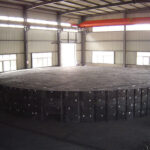Mechanism of Alkali Corrosion Resistance of Carbon-Containing Refractories
The importance of alkali erosion began with a blast furnace damage investigation. Due to the evaporation, infiltration, and agglomeration of the alkali metal, the enrichment in the brick lining, especially at the gap, causes corrosion, cracking, and destruction of the brick lining. The content of K2O and Na2O in the sediment is high. Therefore, the blast furnace workers have developed a micro-porosity product with the goal of low porosity and high alkali resistance and formulated the national standard for the test method of alkali resistance of refractory materials.
The alkali corrosion resistance of carbon-containing refractories depends on its low porosity and compact structure and structure of small pore diameter, and also on the physicochemical properties of its oxidized decarburization layer and the high-temperature phase properties formed by alkali. The alkali etching process is often accompanied by the occurrence of redox reactions, and the formation of a highly viscous glass phase or a dense oxide film can slow down the alkali etching process.
Correctly judge the alkali corrosion process of refractory materials at high temperatures. It is necessary to design test methods according to the conditions of use, improve aluminum-carbon refractory materials according to the conditions of use and different parts, appropriately introduce zirconium-containing raw materials, or develop Sialon-bonded corundum, silicon carbide or zirconium. Corundum refractory materials will promote the development of hot metal pretreatment technology and smelting reduction technology.





